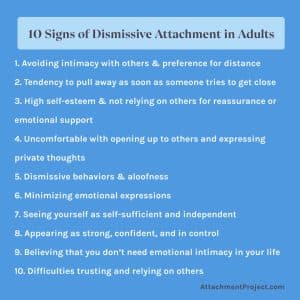Attachment styles describe the way people relate to each other and form relationships. The closer people attempt to get to you the further youll run.
 Avoidant Attachment Style Causes In Childhood And Adult Symptoms
Avoidant Attachment Style Causes In Childhood And Adult Symptoms
Dismissive avoidant attachment tends to be self-sufficient independent emotionally distant and fearful of vulnerability.

Dismissive avoidant attachment style. They always put their own needs first thats why they like independence. Unreliable caretakers in childhood have left them with a deep subconscious fear of intimacy and close attachments are seen as unneeded. There are four attachments styles.
Dismissive Avoidants have apparently high self-esteem and low assessments of others in a relationship. What does dismissive attachment behavior look like. The Dismissive or Avoidant Attachment Style is characterized by independence assertiveness and self-sufficiency.
Distant in a relationship. The person with a dismissive-avoidant attachment style has a mentality that he or she is not in need of other people and can survive being alone or does not need to depend on another for happiness or completeness as a person. Anxious also known as preoccupied Avoidant also known as dismissive Disorganized also known as fearful-avoidant.
WITHYOU -- 25 off All 3 6 8 12 month memberships individual course purchases to support our community during this time. Secure Anxious-attachmentpreoccupied Dismissiveavoidant and Fearful-avoidant. The Types People who have an avoidant attachment approach to relationships are either fearful of intimacy or dismissive of their partners feelings.
They brush feelings aside and devalue human connections. A tendency to avoid displays of feelings. Thats quite challenging if youre encountering a person with a dismissive avoidant attachment.
These are secure and insecure preoccupied fearful avoidance dismissive avoidant and disorganized. Dismissive avoidant Avoidant. Because they learned as infants to disconnect from their bodily needs and minimize the importance of emotions they often steer clear of emotional closeness in romantic relationships.
This is the 1 characteristic of someone with a dismissive avoidant attachment style. If playback doesnt begin shortly try restarting your device. PDS Stay at Home Sale Code.
This can range from avoidance of PDA to avoidance of. They will not try to save the relationship rather they will just bury their heads in the sand and see what happens. When you learn about adult attachment prioritizing your mental health is key.
People with this attachment style have no problem being single. These individuals have a Dismissive-Avoidant attachment style. Individuals in this camp are those who are emotionally unavailable.
There are four styles. Avoidant adults are the opposite of the anxious adult. In fact if someone breaks up with them they will just act like theres nothing they can do.
People who formed an avoidant attachment to their parent or parents while growing up have what is referred to as a dismissive attachment in adulthood. Another important thing is that the avoidant attachment style could vary and there are different types of it. The dismissive avoidant attachment style personality is not worried about the end of a relationship.
They often have a charisma about them are enjoyable in social situations fun to be around and appear to be independent yet have a sense of. Some peoples behavior is characterized by underestimating the importance of human connections and their own feelings. The secure attachment style in adults corresponds to the secure attachment style in children.
Secure anxious-preoccupied dismissive-avoidant and fearful-avoidant. There are usually five commonly understood types of attachment. Those who are Dismissive-Avoidant tend to distance themselves emotionally from their partners.
This can be hard if you have an avoidant attachment style. Adults are described as having four attachment styles. Four adult attachment styles were categorized based on his theory.
Both secure and insecure attachment styles. On the other hand they might be very sociable popular and friendly. Dismissive-Avoidant Attachment in Relationships - YouTube.
What is Dismissive-Avoidant Attachment Style. Avoidant attachment style these dismissive avoidants are high on avoidance low on anxiety. How do you size up.
